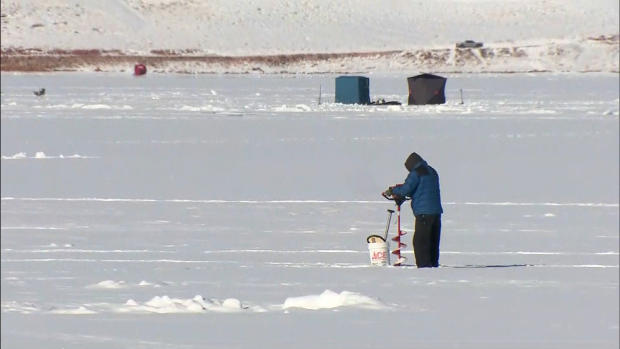Why Colorado's Antero Reservoir Has Winter Temps That Can Span 70 Degrees In 24 Hours
DENVER (CBS4) - Sitting near the geographic center of Colorado is a secluded and serene body of water called Antero Reservoir. During the winter it is known for ice fishing and daily temperature swings as large as 50 to 70 degrees in just 24 hours. The following is a just a few of the big temperature swings recorded in the span of a week.
- Jan. 30, 2022 - High of 37, Low of -31 (a difference of 68 degrees)
- Feb. 1 and 2, 2022 - High of 45, Low of -25 (a difference of 70 degrees each day)
- Feb. 6, 2022 - High of 31, Low of -26 (a difference of 57 degrees)
Antero Reservoir sits in a valley with an elevation just shy of 9,000 feet above sea level. The valley is surrounded by high peaks of the Rocky Mountains on all sides.
High mountain valleys are known for extremely cold temperatures at night. In fact, we often see overnight lows during the winter that consistently fall below zero in places like Gunnison, Alamosa, Kremmling, Frasier, Craig and Tabernash. But the extremes aren't quite as large as we see at Antero Reservoir. To better understand this let's explore some meteorology.
MOUNTAIN/VALLEY BREEZE CYCLE
After sunrise each day Earth's surface begins to warm once in contact with short wave energy from the sun. Energy from the ground heats the air directly in contact with it through a process called conduction. This creates a layer of warm air right against the ground that begins to rise because it has a lower density. The rising air is a process called convection and is responsible for creating a churning motion in the lower atmosphere with air rising up from the valley floor.
At night the process stops. Without the sun there is no "driver" or "mixing" mechanism. With the loss of the sun's energy the ground begins to cool and thus it cools the air in contact with it. But since colder air is dense it can't rise and therefore it hangs near the ground throughout the night.
Now add in the mountains - and picture the layer of cold, dense air sitting along the mountainsides that surround the valley. Because of the density, the cold air begins to ooze down to the valley floor where it collects all night long, resulting in extremely cold temperatures.
WIND (OR LACK OF)
The presence of wind at night plays a huge role in how cold it will be. If there are no weather systems in the area, such as cold fronts and areas of low pressure, we often see light or calm wind speeds at night without the sun to stir things up. The lighter the wind, the more dramatic the cooling can be. If it is windy then overnight lows will typically stay warmer because the mixing motion of the atmosphere will transport warmer air from above down to the valley floor.
CLOUDS (OR LACK OF) AND THE PRESENCE OF SNOW COVER
A clear sky at night will set the stage for strong radiational cooling and lower temperatures. Fresh snow is an added bonus to help a location achieve very cold lows. If there are clouds overnight then temperatures usually remain warmer since clouds act like a blanket and trap energy trying to escape back into the atmosphere.
THE WILD CARD AT ANTERO - LACK OF VEGETATION AND URBANIZATION
If you've read this entire article up to this point and have been wondering why Antero Reservoir always seems to be a little more extreme than places like Gunnison or Kremmling, it has to do with the landscape itself.
Antero Reservoir has very sparse vegetation with no urbanization and little human influence outside of campers and anglers. This plays a big role in the consistency of how it cools so fast at night and warms almost just as fast during the day.





